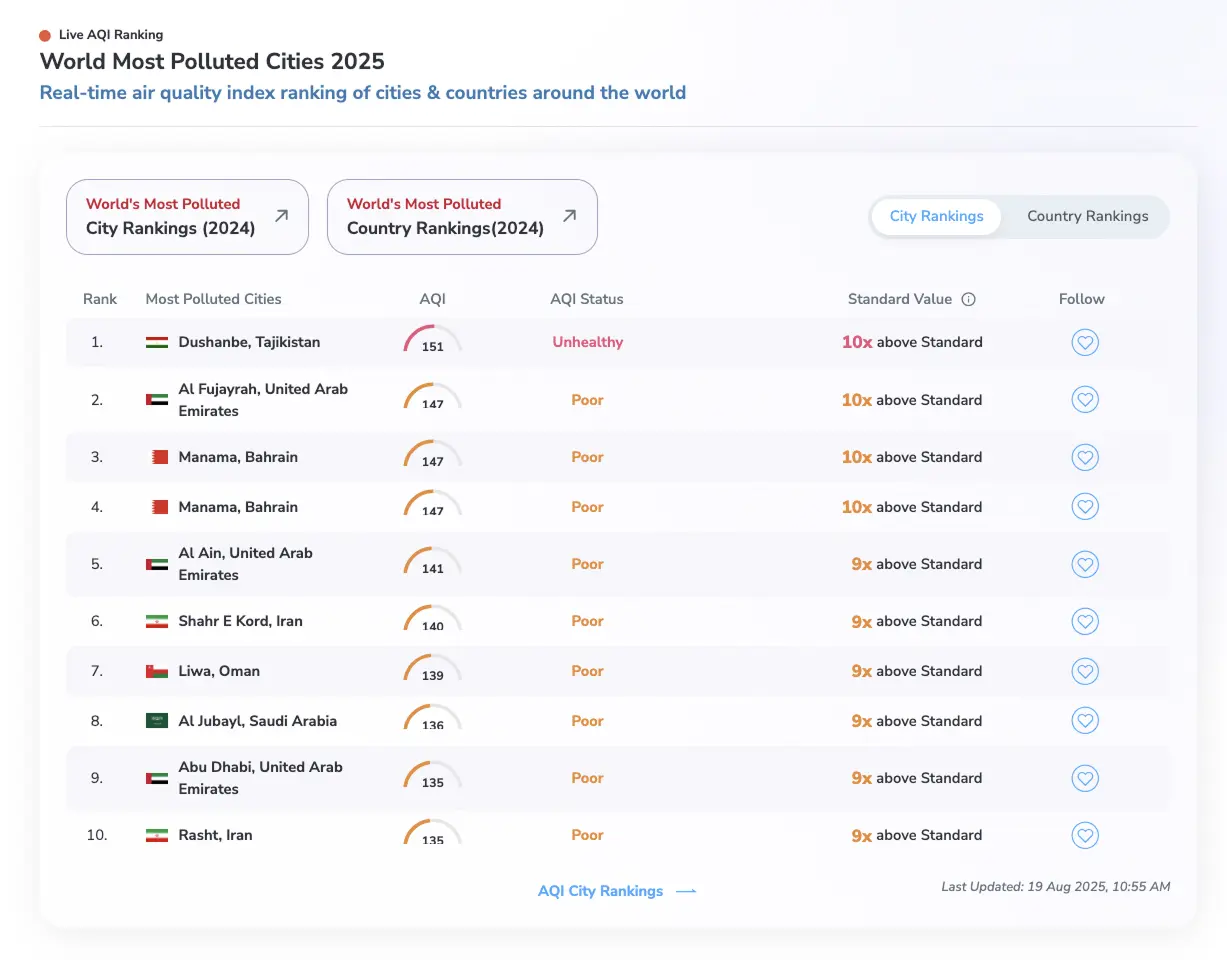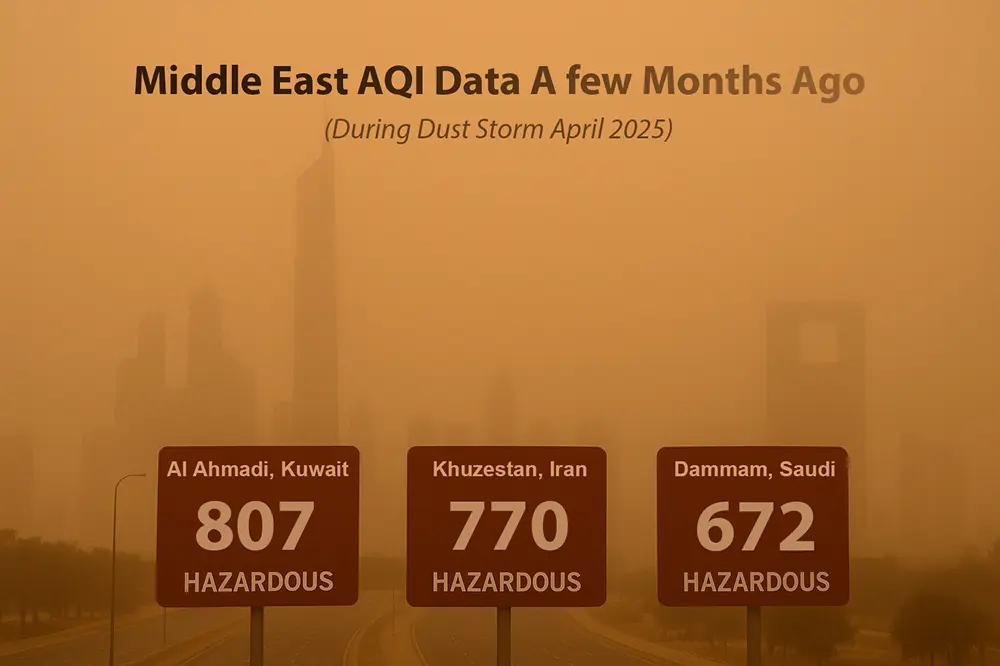Abu Dhabi is now among the top 10 most polluted cities globally, based on current air quality index (AQI) data for August 2025. With an AQI of 135 (categorised as Poor), this marks a serious development in the Middle East air quality crisis. The broader regional context shows that most cities ranking among the worst-polluted are in the Middle East. And it resulted in the Middle East air quality crisis 2025, highlighting a growing environmental and public health concern.
This ranking is not an isolated event. Instead, it reflects a broader Middle East air quality crisis. In fact, most of the top 10 most polluted cities in the world right now are located in the region. Dust storms, rapid construction, heavy traffic emissions, and climate-related factors are combining to make Middle Eastern cities some of the hardest places to breathe clean air in 2025.
The Numbers: Middle East Air Quality Crisis 2025 in Focus

Note: This is real-time AQI data. Rankings and city positions may change over time, so the current rank may differ when you view it.
- Dushanbe, Tajikistan, leads the world list with an AQI of 151, deemed Unhealthy.
- Abu Dhabi ranks ninth with an AQI of 135, within the Poor range.
- Other Middle Eastern cities such as Al Fujayrah, Manama, Al Ain, Liwa, and Al Jubayl also appear in the global top 10.
- In total, six of the top ten most polluted cities are in the Middle East.
This concentration is not coincidental; it reflects a pattern of interconnected regional environmental pressures.
Why Air Quality in Abu Dhabi and in other Middle East Cities so Poor?
Not just in Abu Dhabi, but the top 10 most polluted cities in the World on 19th August 2025 are mostly Middle Eastern. It means the air quality crisis is among these countries. And millions of lives at sake due to sudden increase in air pollution. Here are five key drivers contribute to Abu Dhabi’s high pollution levels:
- Desert Dust Storms – Natural sandstorms frequently raise particulate matter concentrations.
- Construction Dust – Rapid infrastructure development leads to high PM10 levels in urban areas.
- Traffic Emissions – With nearly one million vehicles registered, vehicle exhaust contributes significantly to PM2.5 and NO₂ emissions.
- Industrial Emissions – Proximity to oil refineries and industrial zones adds sulfur dioxide, nitrogen oxides, and other pollutants.
- Persistent Heat and Dry Conditions – These inhibit natural pollutant dispersion and “air washing” via rain.
Spatiotemporal Air Quality Data and Trends
A recent study analyzed hourly NO₂, PM10, and PM2.5 data. As from 19 ground-level monitoring stations across Abu Dhabi between 2015 and 2023, using ARIMA forecasting models. Noteworthy findings include:
- A significant decline in NO₂ levels after 2020, likely due to stricter vehicle emission standards.
- Highest levels of PM10 and PM2.5 observed in 2022, indicating particulate pollution may have intensified despite NO₂ reductions.
- ARIMA model forecasts achieved high accuracy, with Mean Absolute Percentage Error (MAPE) between 7.7% and 8.6%.
- Spatial mapping identified pollution hotspots in areas like Hamdan Street and Mussafah, where industrial and traffic sources are concentrated.
These insights are fundamental for tailoring targeted air quality interventions in Abu Dhabi.
How Air Quality Levels Affect the Health of Residents in the Middle East?
Long-term exposure to elevated PM2.5 levels in the Middle East has been linked to respiratory and cardiovascular diseases, with children and the elderly being particularly vulnerable. Additionally, indoor air quality hasn’t been ignored. Studies highlight that enclosed environments in Gulf countries often contain harmful pollutants like volatile organic compounds and fine particulates.
According to studies on air pollution in the Middle East, poor air quality levels can lead to:
- Respiratory Diseases: Children and elderly residents are particularly vulnerable to asthma, chronic bronchitis, and reduced lung function due to high particulate concentrations.
- Cardiovascular Stress: Long-term exposure to PM2.5 is associated with higher risks of heart disease, hypertension, and stroke.
- Increased Hospital Admissions: Research indicates that spikes in AQI levels correspond with a rise in emergency visits for respiratory and heart-related conditions.
- Reduced Productivity: Beyond physical illness, residents face fatigue, lower workplace productivity, and school absenteeism, all linked to persistent exposure to poor air quality levels.
A 2024 study published in Frontiers in Environmental Science confirmed that PM10 and PM2.5 levels in Abu Dhabi peaked in 2022, worsening the health burden across the city. This aligns with findings from the Environmental Health Perspectives Journal, which warned that air pollution in Gulf countries contributes significantly to the regional rise in chronic disease prevalence.
Efforts and Strategic Opportunities in the Region
Progress is underway. A Khalifa University study attributes some improvement in NO₂ levels to tougher vehicle emissions regulation. The UAE is also pushing its Net Zero by 2050 initiative and expanding renewable energy, especially solar—which now contributes significantly to the energy mix after a 70% increase in capacity between 2022 and 2023. Furthermore, Masdar City in Abu Dhabi is emerging as a sustainable development model that uses green design and renewable energy.
However, coordination gaps remain. Research points to fragmentation among stakeholders, underappreciation of risk uncertainties, and lack of integrated policymaking as obstacles to more effective air quality improvements.
Air Quality Levels in the Middle East Threaten Health of Residents — and Dust Storms a Few Months Ago Made It Worse
The Middle East’s air quality crisis isn’t new. Just a few months ago, in April 2025, severe dust storms swept across Kuwait, Saudi Arabia, Iraq, and Bahrain, driving AQI levels into the hazardous category. Al Ahmadi (Kuwait) hit AQI 538, while Al Qurain recorded 502. In Al Khobar, Saudi Arabia, PM10 soared to 442 µg/m³, forcing schools to close and flights to be suspended.
AQI Levels of These Locations during Dust Storm in Middle East Countries:

These extreme events show that the region’s air quality doesn’t just stay “poor” on ordinary days—it can rapidly deteriorate into an outright health emergency. For residents of cities like Abu Dhabi, where daily AQI is already unhealthy, these sudden spikes amplify the risks, turning routine exposure into life-threatening conditions overnight.
Conclusion
Abu Dhabi’s ranking among the top ten most polluted cities in the world is more than an alarming statistics. As it shows how dust storms, rapid urbanization, industrial activity, traffic, and climate factors combine to endanger air quality. While progress has been made in reducing certain pollutants, effective change demands sustained policy coordination, clean energy adoption, and public health-focused interventions. Without these, the Middle East air quality crisis 2025 and in Abu Dhabi and will continue to threaten millions more.